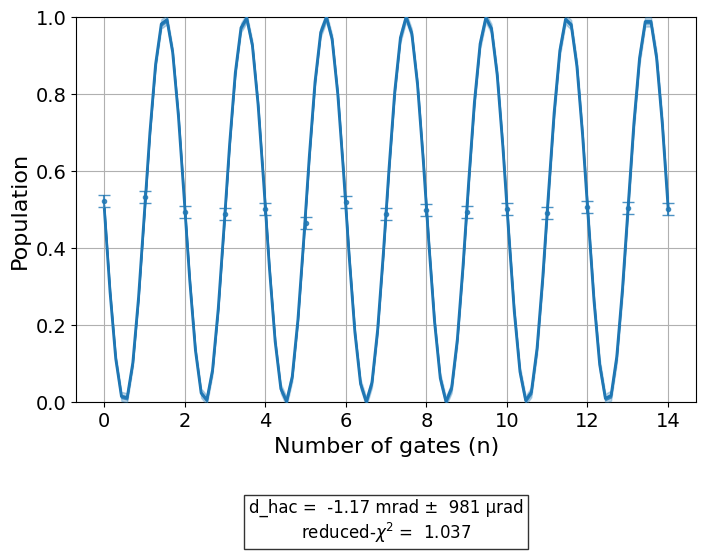Note
This is the documentation for the current state of the development branch of Qiskit Experiments. The documentation or APIs here can change prior to being released.
HalfAngleCal¶
- class HalfAngleCal(physical_qubits, calibrations, backend=None, schedule_name='sx', cal_parameter_name='angle', auto_update=True)[source]¶
Calibration version of the
HalfAngleexperiment.Analysis class reference
Experiment options
These options can be set by the
set_experiment_options()method.- Options
Defined in the class
BaseCalibrationExperiment:result_index (int)
Default value:-1The index of the result from which to update the calibrations.group (str)
Default value:"default"The calibration group to which the parameter belongs. This will default to the value “default”.
Defined in the class
HalfAngle:repetitions (List[int])
Default value: [0,1,2,3,4, …]A list of the number of times that the gate sequence[sx sx y]is repeated.
Defined in the class
BaseExperiment:max_circuits (Optional[int])
Default value:NoneThe maximum number of circuits per job when running an experiment on a backend.
Example
from qiskit import pulse from qiskit_experiments.calibration_management.calibrations import Calibrations from qiskit_experiments.calibration_management.basis_gate_library import FixedFrequencyTransmon from qiskit_experiments.library.calibration.half_angle_cal import HalfAngleCal library = FixedFrequencyTransmon(default_values={"duration": 640}) cals = Calibrations.from_backend(backend=backend, libraries=[library]) exp_cal = HalfAngleCal((0,), cals, backend=backend) inst_map = backend.defaults().instruction_schedule_map with pulse.build(backend=backend, name="y") as sched_build: pulse.play(pulse.Drag(duration=160, sigma=40, beta=5, amp=0.05821399464431249, angle=0.0,), pulse.DriveChannel(0),) inst_map.add("y", (0,), sched_build) cal_data = exp_cal.run().block_for_results() display(cal_data.figure(0)) cal_data.analysis_results(dataframe=True)

name experiment components value quality backend run_time chisq unit bf2755ec @Parameters_ErrorAmplificationAnalysis HalfAngleCal [Q0] CurveFitResult:\n - fitting method: least_squa... good PulseBackendV2 None None None 42acd59e d_hac HalfAngleCal [Q0] 0.0006+/-0.0010 good PulseBackendV2 None 0.820981 rad See also
Superclass
qiskit_experiments.calibration_management.base_calibration_experiment.BaseCalibrationExperimentSuperclass
qiskit_experiments.library.characterization.half_angle.HalfAngle
Initialization
The experiment to update angle of half-pi rotation gates.
- Parameters:
physical_qubits (Sequence[int]) – Sequence containing the qubit for which to run the half-angle calibration.
calibrations (Calibrations) – The calibrations instance with the schedules.
backend (Backend | None) – Optional, the backend to run the experiment on.
schedule_name (str) – The name of the schedule to calibrate which defaults to sx.
cal_parameter_name (str | None) – The name of the parameter in the schedule to update. This will default to ‘angle’ in accordance with the naming convention of the
ScalableSymbolicPulseclass.auto_update (bool) – Whether or not to automatically update the calibrations. By default this variable is set to True.
- Raises:
CalibrationError – if cal_parameter_name is set to
amp, to reflect the transition from calibrating complex amplitude to calibrating the phase.CalibrationError – if the default cal_parameter_name is used, and it is not a valid parameter of the calibrated schedule.
Attributes
- analysis¶
Return the analysis instance for the experiment.
Note
Analysis instance set to calibration experiment is implicitly patched to run calibration updater to update the parameters in the calibration table.
- backend¶
Return the backend for the experiment
- calibrations¶
Return the calibrations.
- experiment_options¶
Return the options for the experiment.
- experiment_type¶
Return experiment type.
- num_qubits¶
Return the number of qubits for the experiment.
- physical_qubits¶
Return the device qubits for the experiment.
Methods
- circuits()¶
Create the circuits for the half angle calibration experiment.
- Return type:
List[QuantumCircuit]
- config()¶
Return the config dataclass for this experiment
- Return type:
- copy()¶
Return a copy of the experiment
- Return type:
- classmethod from_config(config)¶
Initialize an experiment from experiment config
- Return type:
- job_info(backend=None)¶
Get information about job distribution for the experiment on a specific backend.
- Parameters:
backend (Backend) – Optional, the backend for which to get job distribution information. If not specified, the experiment must already have a set backend.
- Returns:
A dictionary containing information about job distribution.
”Total number of circuits in the experiment”: Total number of circuits in the experiment.
”Maximum number of circuits per job”: Maximum number of circuits in one job based on backend and experiment settings.
”Total number of jobs”: Number of jobs needed to run this experiment on the currently set backend.
- Return type:
dict
- Raises:
QiskitError – if backend is not specified.
- run(backend=None, sampler=None, analysis='default', timeout=None, backend_run=None, **run_options)¶
Run an experiment and perform analysis.
- Parameters:
backend (Backend | None) – Optional, the backend to run on. Will override existing backend settings.
sampler (BaseSamplerV2 | None) – Optional, the sampler to run the experiment on. If None then a sampler will be invoked from previously set backend
analysis (BaseAnalysis | None) – Optional, a custom analysis instance to use for performing analysis. If None analysis will not be run. If
"default"the experimentsanalysis()instance will be used if it contains one.timeout (float | None) – Time to wait for experiment jobs to finish running before cancelling.
backend_run (bool | None) – Use backend run (temp option for testing)
run_options – backend runtime options used for circuit execution.
- Returns:
The experiment data object.
- Raises:
QiskitError – If experiment is run with an incompatible existing ExperimentData container.
- Return type:
- set_experiment_options(**fields)¶
Set the experiment options.
- Parameters:
fields – The fields to update the options
- Raises:
AttributeError – If the field passed in is not a supported options
- set_run_options(**fields)¶
Set options values for the experiment
run()method.- Parameters:
fields – The fields to update the options
See also
The Setting options for your experiment guide for code example.
- set_transpile_options(**fields)¶
Add a warning message.
Note
If your experiment has overridden _transpiled_circuits and needs transpile options then please also override set_transpile_options.
- update_calibrations(experiment_data)[source]¶
Update the value of the parameter in the calibrations.
The parameter that is updated is the phase of the sx pulse. This phase is contained in the complex amplitude of the pulse. The update rule for the half angle calibration is therefore:
\[A \to A \cdot e^{-i{\rm d}\theta_\text{hac}/2}\]where \(A\) is the complex amplitude of the sx pulse which has an angle which might be different from the angle of the x pulse due to the non-linearity in the mixer’s skew. The angle \({\rm d}\theta_\text{hac}\) is the angle deviation measured through the error amplifying pulse sequence.
- Parameters:
experiment_data (ExperimentData) – The experiment data from which to extract the measured over/under rotation used to adjust the amplitude.